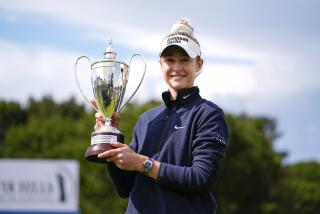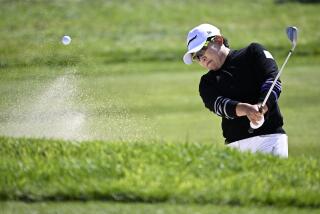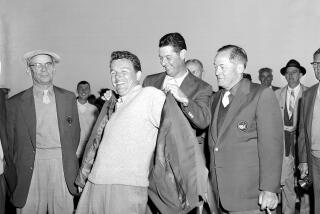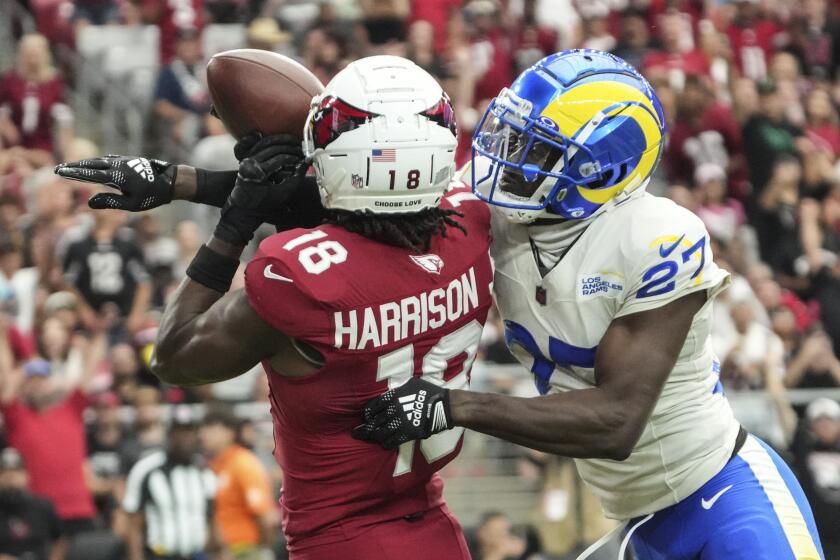Inkster Reveled in Relative Obscurity
The weekend when Juli Inkster won the Safeway LPGA Golf Championship in Portland, Ore.--a late September tournament of no special importance except that by winning, Inkster qualified for the LPGA Hall of Fame--pretty much nobody but her husband Brian and her two daughters, Hayley and Cori, her parents and a little gathering of friends and family paid attention.
Or, as Inkster says, “The whole world checked out.”
For on the weekend when Inkster accomplished something she never thought possible, when she stamped herself as one of the best women’s golfers in history, on the other side of the country the U.S. men were winning, in spine-tingling, goosebump-inducing fashion, the Ryder Cup. So Inkster and her moment became nothing but a dot, dot, dot. You know . . . and in other golf action, Juli Inkster qualified for the Hall of Fame.
“But,” Inkster says now, “I was totally fine with that. I was an afterthought, but not to the people who mattered. Because the tournament was in Portland, I probably had 20 or 30 family members around. So that was the best thing and that was what meant the most. My daughters were there. My husband was there. If nobody else knew, that was fine.”
Inkster, 39, married for 19 years to 49-year-old Brian, the golf pro at Los Altos Country Club near San Jose, and proud mother of sports-addicted Hayley, 9, and Cori, 5, is coming to Newport Beach Thursday as part of the fifth Diners Club Matches, which will take place at Pelican Hill Golf Club. In this team competition, which includes men and women and which will showcase Jack Nicklaus and Tom Watson, Fred Couples and Karrie Webb, Inkster will arrive with the best 1999 credentials of the bunch.
Inkster has won five tournaments this year, including two more majors--the U.S. Open and the McDonald’s LPGA Championship--improving her career-win total to 25, including five majors. Those two majors completed a career Grand Slam for Inkster, one of each of the four majors (Nabisco Dinah Shore and du Maurier Classic being the other two).
And Inkster also added the Hall of Fame.
Since we hardly celebrated Inkster’s accomplishment in September, let’s do it now.
Inkster is a women’s sports experiment taking place in front of us. She got married to Brian when she was 20 and became a pro in 1983 when she was 23. Not many women had professional athletic careers. Even fewer have had to figure out how to become mothers as well. To become a top-level athlete, as Juli says, “you have to be a little selfish. Until I had kids, for almost my whole life my whole day was being Juli Inkster. It was about me. And then that all changed.”
It is a change women athletes make that men don’t. No matter what, no matter how involved a male athlete is with his children, it is mom who soothes tears, it is mom who bandages scrapes, it is mom who is supposed to be there. It is still easier for the top-level male athlete to continue to craft a day that is all about him. Women athletes who become parents can’t.
“I know,” Brian says, “how hard it was for Juli for a few years. She was averaging two tournament wins a year until 1990, when Hayley was born. Juli never talked about it specifically, but I know she wasn’t satisfied with her golf. I know she wondered if it was worth it.”
From 1993 until 1997, Inkster didn’t win a tournament. “The best thing I’ve ever done is have Hayley and Cori,” Inkster says. “They’re like my best buddies now. But I didn’t know how hard it would be. You can be told, but you just don’t know about the crying, about whether to feed ‘em or not, about whether to take ‘em for a walk, about how to just not kill ‘em.
“It was just really tough. My mom had been a stay-at-home mom. Here I was, traveling every week with kids. The oldest one seemed to get sick every week. I wasn’t playing great golf. . . . you start to worry. Are these kids growing up delinquent because of me? There were a lot of times when I was running around with my head cut off, feeling like I wasn’t putting 100% into my kids and not 100% into my golf. That’s not how it was, but that’s how I felt.”
Inkster could not quite let go of golf though. In 1993, she finished 47th on the LPGA money list; in 1994, the year Cori was born, she finished 49th; in 1995, it was 33rd; in 1996, it was 21st, and for the last two years, it was sixth. Things were getting better, little by little. “I couldn’t win like I was used to,” Inkster says, “but my golf was getting better and my life was getting organized.”
In 1998, Hayley watched her mom help the U.S. team win the Solheim Cup, the women’s equivalent of the Ryder Cup. “That was a turning point for me, mentally,” Inkster says. “Hayley helped us raise the American flag and on the way to the airport afterward she turned to me and said, ‘Mom, now I understand why you do this. This was the best week I ever had.’ She told me she wanted to be part of something like that again. Now, she’s always got a calendar, counting the days to the next Solheim Cup.”
Cori has had her golf epiphany too. “She goes around telling everyone her mom is in the Hall of Fame,” Inkster says. “Usually people don’t know what she’s talking about.”
Until last January, when the LPGA changed its Hall of Fame requirements, making them more realistic for a tour much deeper in talent than in the days when Mickey Wright or Carol Mann only had to really worry about beating four or five other players, Inkster had no thoughts of the Hall of Fame.
Under the old rules, an LPGA player needed 30 career wins, which included at least two majors; or 35 tournament wins with at least one major, or 40 and no majors. How hard was that? Only 14 players had qualified.
“It was kind of a joke,” Inkster says. “Patty Sheehan is a good friend of mine. When she finally made it, we were joking that you might as well call it the Dead Hall of Fame. Back at the beginning, only five or six girls had a real chance of winning every week.”
Now there is a more complicated point formula that assigns numerical value to tournament wins, majors, player of the year awards. A player needs 27 points to qualify. When the rules were changed in January, Inkster had 20 points. “Mentally,” Inkster says, “maybe that gave me a boost, gave my career a boost. I went from thinking I could never get in to thinking I could do it. I don’t think I expected to do it in one year though.”
When you become a mother in 1990 and again in ‘94, when your body goes through the physical changes of motherhood and your psyche adjusts to making a little girl and her 22 stitches more important than tinkering with your backswing, it is not so easy to win golf tournaments.
Inkster understands now. She has made the adjustments. Not to her backswing but to her mind-set.
“My daughters know they are loved,” she says. “My husband and I have made a stable home for them. Maybe there are some soccer games I don’t get to, but then in the winter I can coach Hayley’s basketball team. I’ve come to a peace that I can’t be there all the time but I can give them what they need.
“And, you know what? When I understood that, my golf game got better. I don’t take every game as life and death. I’ve just matured, I guess.”
So welcome to the Hall of Fame, Juli Inkster. You deserve a nice round of applause. From all of us.
Diane Pucin can be reached at her e-mail address: [email protected]
More to Read
Go beyond the scoreboard
Get the latest on L.A.'s teams in the daily Sports Report newsletter.
You may occasionally receive promotional content from the Los Angeles Times.










